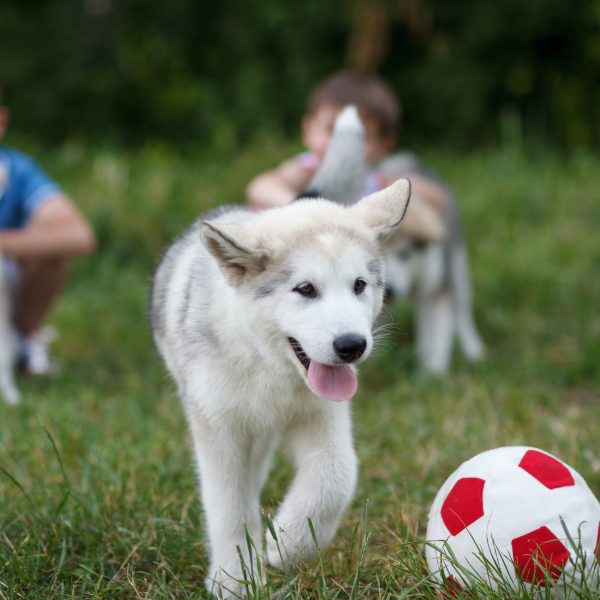Best Practices Guide to Interactions Between Young Kids and Puppies
 Newborn with Puppy
Newborn with Puppy
Bringing a newborn home is a wonderful time for a family. Bringing a newborn home to a puppy or dog, however, can be daunting if you’re not prepared. Before bringing a baby home, there are a few things you should do to prepare your dog for children and to keep the home peaceful and your baby – and pup – happy.
Before a due date is even set, you should play recordings of a baby cooing and crying for your dog. Then, they will be familiar with the sounds of a baby when the real thing arrives. You should also give them a piece of kibble every time they respond to this noise calmly. Then, you will not have to worry about your dog when you need to care for your child.
You will also establish a positive emotion with your child. As you get closer to your due date, give the dog plenty of time to sniff around the nursery and learn about each onesie, toy, and gadget. Your dog may actually be as excited as you for a new family member and will want to learn as much as they can beforehand. This is a great way to introduce them to the idea of a baby before the baby is present.
Once your baby is born, have another member of the family take a blanket, or onesie, that your baby has used to your home. This will introduce your dog to the scent of the newborn well before you have to come home.
Finally, when you introduce the baby to your puppy be sure to say hello to the dog first and then introduce the two. When you introduce them, make sure you supervise the entire interaction.
Supervision is essential for introducing a new dog to other pets, another dog, new people, and, of course, kids. Both puppy and baby may not understand what is too rough just yet. Keeping both of them safe is paramount for them to have a positive relationship throughout their lives.
Toddler with Puppy
Visiting Dogs and Puppies
If you have a toddler and you are visiting a dog, there are a few things you should establish before allowing the two to meet. Beforehand, make sure the puppy has the basic commands of “sit,” “stay,” and “come” established so you will have boundaries if need be.
Then, make sure the child understands that they will need to be gentle and patient with the puppy. Although toddlers do not want to hurt an animal, they are still developing motor skills and may not have learned how much is too much or that something is painful. You will need to let them know what a gentle pet is, and what is too rough.
Once the child and puppy meet, let the child know to approach the dog calmly and quietly. Now, the dog will not be nervous or jumpy. Then, be sure to get the okay from the owner to pet the dog so there will be no surprises for you, your child, or the dog’s owner.
If all goes well, the child should be allowed to spend supervised time with the pup without worry. If the dog is still shy or nervous, give them some space. They will warm up to the child once they understand they are not a threat.
Adopting a Puppy
If you are adopting a puppy, be sure your child or children know the commands the pup will understand. There will be less confusion while you are training your pup. Once commands are established, you should help your child understand where they can pet the dog and where they cannot.
This will keep the dog from being harmed in any way. It will also help prevent biting or general protests from your new dog. Be sure to explain in detail to the child how to pet the puppy before allowing the toddler to spend unsupervised time with the dog.
Finally, make sure the child understands the dog body language. Explain what happens when the dog is happy and when they need space. Then, your toddler won’t hurt the dog unintentionally and your pup will not feel the need to protect themselves from the child.
Children and dogs go together like peanut butter and jelly. If you have a child, it is a wonderful idea to get them a puppy, especially from a reputable breeder or shelter. A dog can teach them patience, responsibility, and friendship.
Before adding a dog to the family, however, you should be sure you know how you want to train your puppy. You should also prepare your child for their new friend and supervise interactions between young kids and puppies so there are no surprises along the way.
